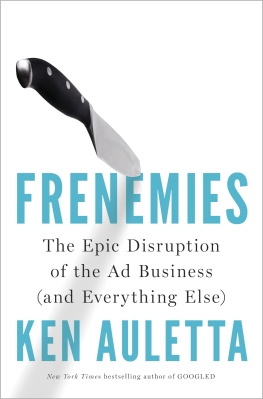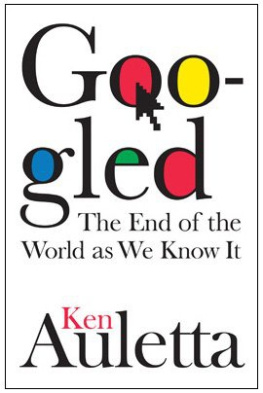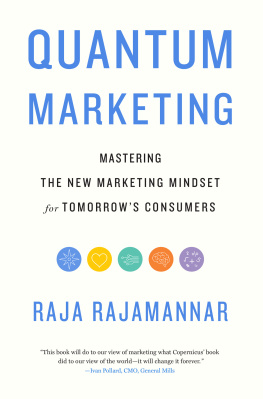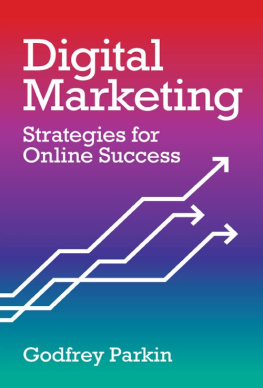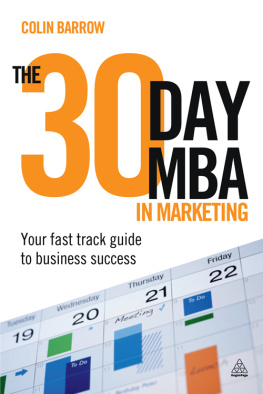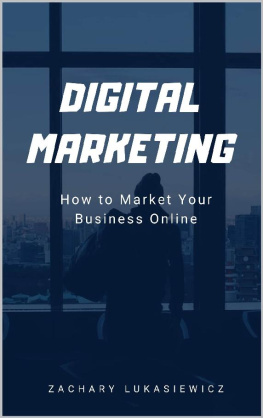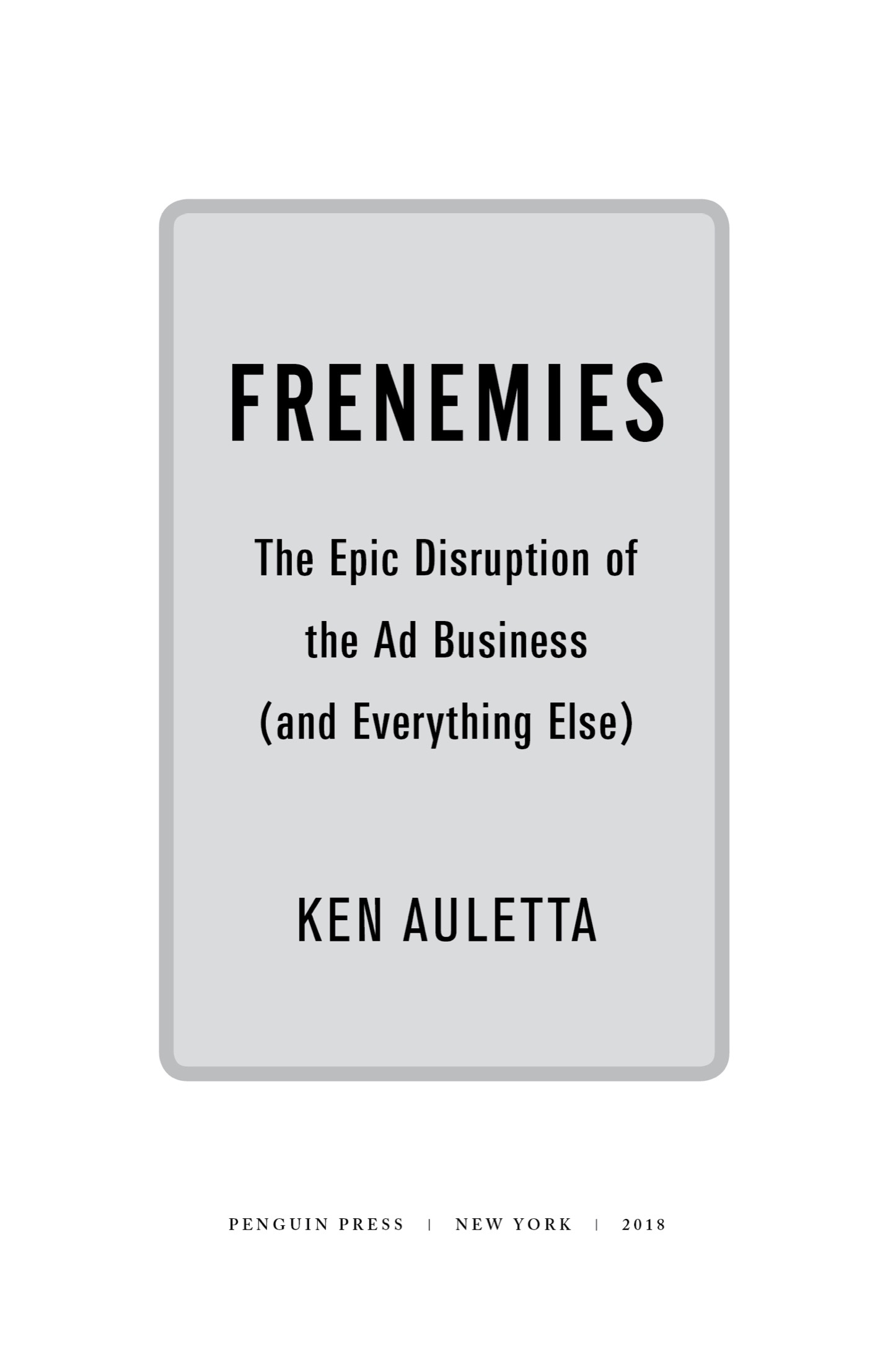ALSO BY KEN AULETTA
Googled: The End of the World as We Know It
World War 3.0: Microsoft and Its Enemies
The Highwaymen: Warriors of the Information Superhighway
Three Blind Mice: How the TV Networks Lost Their Way
Greed and Glory on Wall Street: The Fall of the House of Lehman
Media Man: Ted Turners Improbable Empire
Backstory: Inside the Business of News
The Art of Corporate Success: The Story of Schlumberger
The Underclass
Hard Feelings: Reporting on the Pols, the Press, the People and the City
The Streets Were Paved with Gold: The Decline of New York, an American Tragedy
PENGUIN PRESS
An imprint of Penguin Random House LLC
375 Hudson Street
New York, New York 10014
penguin.com

Copyright 2018 by Ken Auletta
Penguin supports copyright. Copyright fuels creativity, encourages diverse voices, promotes free speech, and creates a vibrant culture. Thank you for buying an authorized edition of this book and for complying with copyright laws by not reproducing, scanning, or distributing any part of it in any form without permission. You are supporting writers and allowing Penguin to continue to publish books for every reader.
LIBRARY OF CONGRESS CATALOGING-I N-PUBLICATION DATA
Names: Auletta, Ken, author.
Title: Frenemies : the epic disruption of the ad business (and everything else) / Ken Auletta.
Description: New York : Penguin Press, [2018] | Includes bibliographical references and index.
Identifiers: LCCN 2018006195 (print) | LCCN 2018007151 (ebook) | ISBN 9780735220874 (ebook) | ISBN 9780735220867 (hardcover)
Subjects: LCSH: Advertising agenciesHistory. | AdvertisingHistory. | MarketingHistory.
Classification: LCC HF6178 (ebook) | LCC HF6178 .A895 2018 (print) | DDC 659.10973dc23
LC record available at https://lccn.loc.gov/2018006195
Version_2
For Matt and Sam
CONTENTS
INTRODUCTION
In a 1970 TV commercial, a group of child actors portraying Louis Armstrong, Fiorello La Guardia, and Barney Pressman as kids are sitting on a New York City stoop and asking each other what they hope to be one day. Armstrong says he wants to be a musician. La Guardia says he wants to be mayor of New York. The bespectacled Barney Pressman is quiet, so they prod him: Whaddaya gonna be when you grow up, Barney? Pausing to adjust his glasses, the future founder of Barneys clothing store says, I dont know. But youll all need clothing.
For more than three decades, in books and in my Annals of Communications pieces and profiles for The New Yorker, I have reported on the digital hurricane that has swept across the media industry. I have tried to follow the money, to understand the source of the economic harm that has struck newspapers, magazines, television, and radio, all reeling from shrinking advertising revenuerevenue now fueling Google, Facebook, and a myriad of other new digital enterprises. You can almost hear the young Barney Pressman trilling the world, Youll all need advertising and marketing.
Worldwide, advertising and marketing is variously said to be a $1 trillion to $2 trillion industry. Of that astronomical sum, roughly three quarters is categorized as marketing dollars. Often, rather than joining together the words advertising and marketing, we employ the shorthand, advertising. We do so because advertising is a more familiar term, and to utter both terms together is a mouthful. In fact, advertising and marketing are interchangeable. They take different forms, but each involves a sales pitch. A thirty-second TV ad or a full-page ad in a newspaper seeks to sell something, which is also a marketing pitch. A direct mail or newly designed brand name or email solicitation or giveaway coupon is listed as a marketing expenditure, but its also an advertising sales pitch. So the two categories are really one.
Yet advertising and marketing, like the media industry it has long subsidized, is convulsed by change, struggling itself to figure out how to sell products on mobile devices without harassing consumers, how to reach a younger generation accustomed to dodging ads, how to capture consumer attention in an age where choices proliferate and a mass audience is rare.
In the course of my work as a journalist, I have tended to shift back and forth between the disrupters and the disrupted. My first book, The Streets Were Paved with Gold, published in 1978, chronicled how New York City had been hit by a Category 5 economic and social storm that shattered its manufacturing base and spurred the flight of its middle class. My focus on the people on the wrong end of change continued in 1981, in a three-part series in The New Yorker that grew into a book, The Underclass. A reporting sojourn to Wall Street in the mid-1980s resulted in Greed and Glory on Wall Street, a battlefield account of the corrosive greed that brought low Lehman Brothers, the oldest partnership on Wall Street, and signaled the Wall Street gluttony that produced insider trading scandals and would bear such disastrous fruit in 2008.
Its fair to say that at this point I was a naf about the advertising industrys true economic power. That began to change in 1985, when I embarked on a nearly six-year odyssey through the world of network television while reporting my book Three Blind Mice, a report on how the three dominant television networksCBS, NBC, and ABCwere being disrupted by a new technology, cable. Advertising was central to that story, for unlike cable, the networks were 100 percent reliant on advertising. And so when the estimable Tina Brown, the new editor of The New Yorker, offered a regular platform in the magazine, which she called the Annals of Entertainment, I demurred. I told her that in reporting Three Blind Mice I glimpsed how the world of media was being transformed, and so we needed a broader rubricthe Annals of Communicationsbecause studios and publishers and television and digital companies were increasingly invading each others turf.
Over the next quarter century, unsettling change was the subject of much of my work for the magazine and for my books, and the advertising industry was often a backdrop for the stories, and usually an underexplored one. I witnessed the flight of advertisers from old to new media with my reporting for The New Yorker about Google, which led to the book Googled: The End of the World as We Know It. The flight of advertisers from old to new media started in the late 1990s and accelerated in the new century, and its impact was hard to miss. Less obvious was the impact on the ad industry itself. In the public imagination, we were still in the age of Don Draper, but I began to see more and more clearly how this industry that had been intrinsic to the disruption of old media was itself facing fundamental challenges to its existence.
Trying to understand the media without understanding advertising and marketing, its fuel supply, is like trying to understand the auto industry without regard to fuel costs. A war correspondent would be derelict not to try to calculate whether General Patton had enough gas in his Third Army tanks to race across France in 1944 (he did not). But its not merely that a reporter covering the communications business would be remiss not to follow the up to $2 trillion advertising and marketing sector; anyone who takes a moment to ponder this pool of money cant avoid the inescapable truth that capitalism could not exist without marketing. True, the force of marketing is often malign, seeking to manipulate the emotions of consumers. Readers of this book will, hopefully, share my rage at the many tricks marketers practice. But marketing has a purpose in a free society, and intellectual honesty compels us to recognize that those who sell products need a way to share information about them with consumers. In a non-state-dominated economy, advertising is the bridge between seller and buyer. It would seem an obvious statement, but Ive found it bears repeating. And that bridge is teetering, jolted by consumers annoyed by intrusive ads yet dependent on them for free or subsidized media. In this sense, consumers are frenemies.

